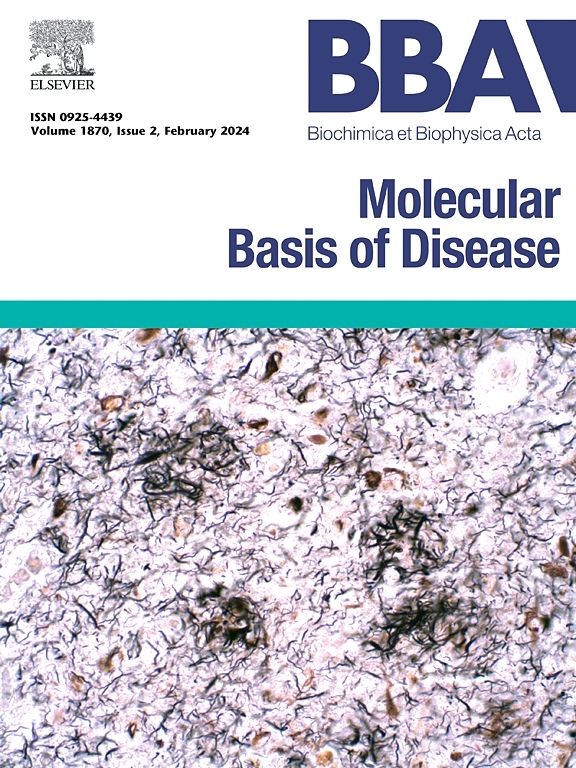Anxa10 and neuropathic pain: Insights into dysregulation of endoplasmic reticulum-mitochondria contact tethering complex and therapeutic potential
IF 4.2
2区 生物学
Q2 BIOCHEMISTRY & MOLECULAR BIOLOGY
Biochimica et biophysica acta. Molecular basis of disease
Pub Date : 2025-04-16
DOI:10.1016/j.bbadis.2025.167856
引用次数: 0
Abstract
The stability of membrane contact sites is critically dependent on Endoplasmic Reticulum mitochondria contact tethering complexes (EMCTCs), and dysregulation of these sites has been implicated in neuropathic diseases. In this study, we examined the role of Annexin A10 (Anxa10), a calcium-dependent protein, in neuropathic pain by investigating its influence on EMCTCs dysregulation. Using RNA sequencing, western blotting, and behavioral assays, we observed that spared nerve injury (SNI)-induced neuropathic pain significantly increased Anxa10 expression levels within the spinal dorsal horn (SDH) of mice. By employing cell-specific gene regulation via the Cre/loxp system, we utilized loxp-modified adeno-associated virus vectors to modulate Anxa10 expression in GAD2-Cre (inhibitory neurons), vGlut2-Cre (excitatory neurons), and Fos-Cre (activity-induced neurons) transgenic mice. Our results demonstrated that specific down-regulation of Anxa10 in excitatory neurons within the SDH alleviated neuropathic pain, whereas up-regulation of Anxa10, regardless of cell type, induced spontaneous pain in mice. Ultrastructural analysis of the endoplasmic reticulum (ER) and mitochondria, as well as double immunofluorescence staining, revealed that downregulation of Anxa10 mitigated the SNI-induced reduction in ER-mitochondrial distance. Additionally, it attenuated the SNI-induced upregulation of key components of EMCTCs, including IP3R, GRP75, and VDAC1, while preventing the SNI-induced downregulation of NCX3 expression. Furthermore, we formulated and validated the hypothesis that SGK1 and PI3K are positioned downstream of Anxa10. The up-regulation of Anxa10 compromised mitochondrial integrity and disrupted mitochondrial networks, ultimately leading to elevated oxidative stress. Collectively, these findings suggest that Anxa10 represents a promising therapeutic target for correcting EMCTCs dysregulation and mitigating neuropathic pain.
Anxa10和神经性疼痛:内质网-线粒体接触系缚复合物的失调和治疗潜力的见解
膜接触位点的稳定性严重依赖于内质网线粒体接触系缚复合物(emctc),这些位点的失调与神经性疾病有关。在这项研究中,我们通过研究膜联蛋白A10 (Anxa10)对emctc失调的影响,研究了钙依赖性蛋白在神经性疼痛中的作用。通过RNA测序、western blotting和行为学分析,我们观察到,SNI诱导的神经性疼痛显著增加了小鼠脊髓背角(SDH)内Anxa10的表达水平。通过Cre/loxp系统进行细胞特异性基因调控,我们利用loxp修饰的腺相关病毒载体调节了GAD2-Cre(抑制性神经元)、vGlut2-Cre(兴奋性神经元)和Fos-Cre(活性诱导神经元)转基因小鼠中Anxa10的表达。我们的研究结果表明,SDH内兴奋性神经元中特异性下调Anxa10可减轻神经性疼痛,而上调Anxa10,无论细胞类型如何,均可诱导小鼠自发性疼痛。内质网(ER)和线粒体超微结构分析以及双免疫荧光染色显示,下调Anxa10可减轻sni诱导的ER-线粒体距离减少。此外,它减弱了sni诱导的emctc关键成分IP3R、GRP75和VDAC1的上调,同时阻止了sni诱导的NCX3表达下调。此外,我们提出并验证了SGK1和PI3K位于Anxa10下游的假设。Anxa10的上调破坏了线粒体完整性,破坏了线粒体网络,最终导致氧化应激升高。总的来说,这些发现表明Anxa10代表了纠正emctc失调和减轻神经性疼痛的有希望的治疗靶点。
本文章由计算机程序翻译,如有差异,请以英文原文为准。
求助全文
约1分钟内获得全文
求助全文
来源期刊
CiteScore
12.30
自引率
0.00%
发文量
218
审稿时长
32 days
期刊介绍:
BBA Molecular Basis of Disease addresses the biochemistry and molecular genetics of disease processes and models of human disease. This journal covers aspects of aging, cancer, metabolic-, neurological-, and immunological-based disease. Manuscripts focused on using animal models to elucidate biochemical and mechanistic insight in each of these conditions, are particularly encouraged. Manuscripts should emphasize the underlying mechanisms of disease pathways and provide novel contributions to the understanding and/or treatment of these disorders. Highly descriptive and method development submissions may be declined without full review. The submission of uninvited reviews to BBA - Molecular Basis of Disease is strongly discouraged, and any such uninvited review should be accompanied by a coverletter outlining the compelling reasons why the review should be considered.

 求助内容:
求助内容: 应助结果提醒方式:
应助结果提醒方式:


